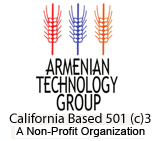Anti-Hail System Benefits Rural Armenia
| February 1, 2006
Yerevan, Armenia — During the first 10 years of independence following the collapse of the Soviet Union, a shortage of funds prevented the implementation and development of anti-hail programs in Armenia. The resulting losses to Armenian farmers were staggering; each year farmers incurred losses in the tens of millions of dollars due to hail. In 2004, under the order of President Robert Kocharian, a bold new program was initiated, in which the latest anti-hail techniques, developed worldwide, would be put to use in Armenia. Reports of progress in a new anti-hail system in Argentina led to a visit by Minister of Agriculture Davit Lokyan, who determined that the new system, which employed technology developed by French scientists, would be ideal for Armenia’s unique climate. This technique utilized cannon like devices in which acetylene is ignited and the blast shatters hail bearing clouds. Arrangements were made for the purchase of 15 of the hail blasters and their delivery to the region of Ashtarak, in the province of Aragatsotn in Armenia. In 2003 Mr. Lokyan visited Fresno, California where he held a special meeting with the board of directors of the Armenian Technology Group, Inc. (ATG), a California non-profit corporation, where he presented and discussed the idea. “Mr. Lokyan is a hands-on Minister who is very much interested in finding different ways to help the farmers in Armenia, and we are honored and pleased to work with him,” said ATG president Nubar Tashjian, J.D. “Over 50% of Armenia’s productivity is generated through the farming sector. With a program of “hail busting” in place Armenian farmers will see the immediate results of their labor and investments.” The anti-hail systems were brought to Armenia by way of the port of Poti, in Georgia, and later installed in several villages near Ashtarak. Vahan Ghoukasyan, executive director of the Support Fund of Villages and Agriculture in Armenia, organized the installation. Emphasizing the importance of the new system to Armenia’s farmers, he said, “Armenia is in a severe hail region. Without a new anti-hail program, many farmers would simply give up, unable to recover from almost yearly losses due to hail.” To be operational, the new devices require acetylene, where the fuel is stored in sponges placed inside the acetylene steel tanks. Ghoukasyan explained, “Each anti-hail device requires 12 such tanks of acetylene which are manufactured in a factory in Russia. Purchase and delivery of the tanks, 180 in all, was taken care of by the California-based Armenian Technology Group. The role they played in getting this program off the ground is invaluable — beyond words.” “Our goal is to reduce poverty in rural Armenia. The anti-hail system will help protect the farmers from additional crop losses each year. It will help increase their productivity level, increase their income potential and for sure will create new jobs and opportunities in the farming community,” said Varoujan Der Simonian, executive director of ATG. In the fall of 2005, initial firing of the systems was successfully completed. “Experts from Argentina will be here in the spring,” Ghoukasyan said. “They will familiarize our own technicians with the workings of the hail-blasters. This way, our people will be able to run the new systems, which will be fully operational in 2006.” Each of the 15 systems protects approximately 200 hectares from hail damage. “This means nearly 3,000 hectares (6,500 acres) will be protected from hail damage,” Ghoukasyan said. “And this is only the beginning.” Farmers look to future In Brazil, another country utilizing the new anti-hail system, over 3,000 of the blasters are in use. “There, as in Argentina and France, farmers buy the systems,” Ghoukasyan explains. “If we count crop loss from hail damage, which reaches the tens of millions annually, we see that the systems pay for themselves in a matter of a year or two, or possibly three to four years at the most, for wheat growers. Tree fruit growers and grain growers alike benefit from the use of the systems. And we in Armenia can produce acetylene at Yerevan’s Nairit factory, which can make fuel inexpensive. In every way it is a great program.” Currently, the anti-hail systems protect agricultural land in several villages of Armenia near Ashtarak. “This is just one province,” says ATG’s Yerevan director, Gevorg Gabrielyan. “Farmers in other regions that are severely affected by hail, such as the province of Shirak, and in Spitak, in the province of Lori, have sent applications to the government, requesting the new system for their regions. If two or three farmers, who own 200-300 hectares, get together and purchase the devices, their problems will be solved. We all know what effect natural disasters, such as a short, five-minute hail storm, can have on agriculture, and on a farmer’s livelihood. We needed a new, educated approach to this problem. The program is perfect for Armenia. After two or three years of working on this program its benefits will be clearly evident.” For more information about how you can help Armenia’s farmers, contact the ATG office at (559) 224-1000 or by e-mail (info@atgusa.org). Tax-deductible donations can be sent to ATG; 1300 E. Shaw, Suite 149; P.O.Box 5969; Fresno, CA 93755-5969. |
|


Follow Us